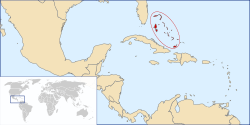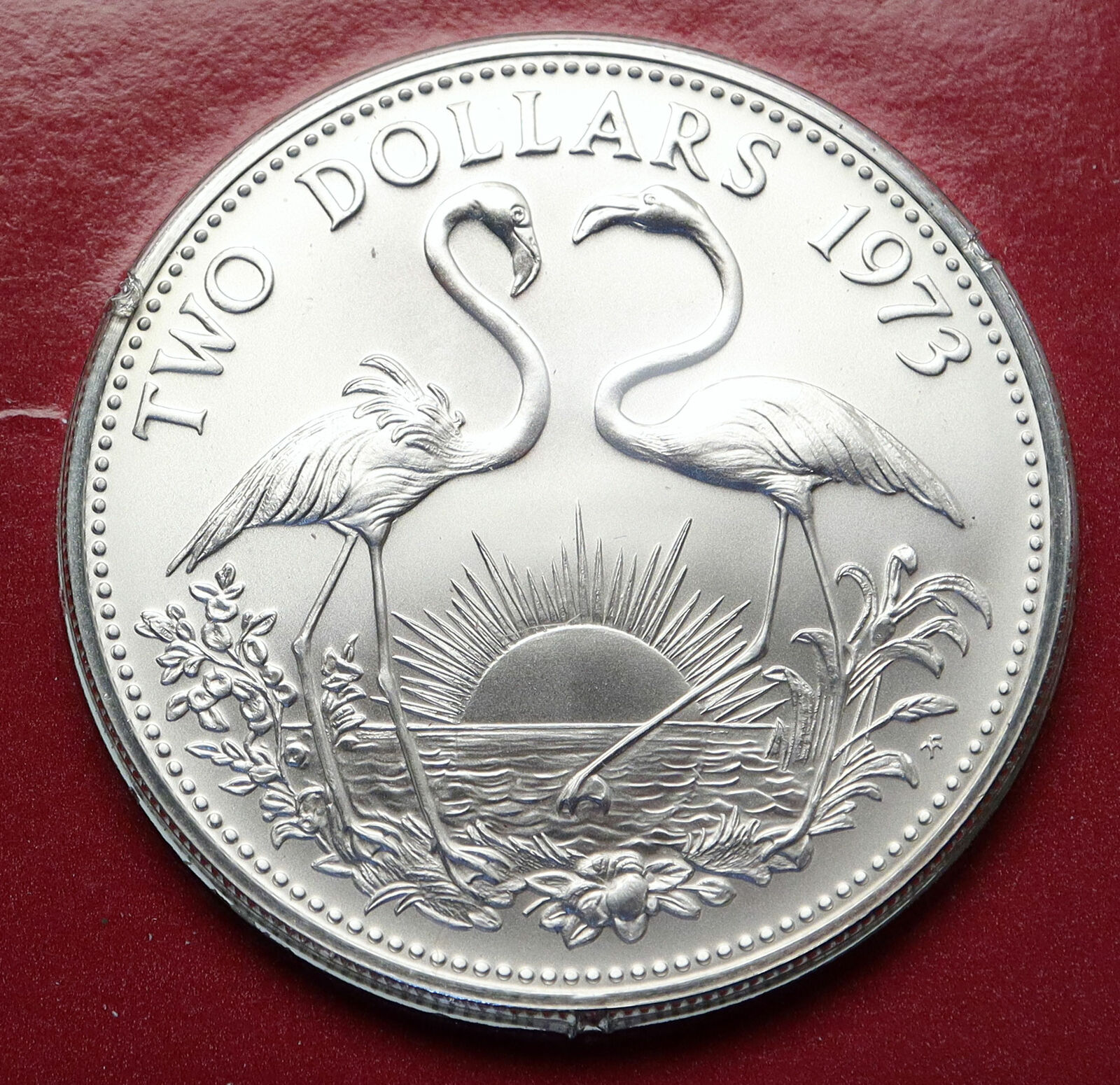|
Bahamas – Independence 10 July 1973 Commemorative
1973 Proof Silver 10 Dollars 50mm (49.72 grams) 0.925 Silver (1.4795 oz. ASW)
Reference: KM# 42
Certification: NGC PF 68 ULTRA CAMEO 2864289-011
COMMONWEALTH OF THE BAHAMAS · ELIZABETH II ·, Bust of the Queen Elizabeth II turned to the right.
INDEPENDENCE 10 JULY 1973 · 10 DOLLARS ·, Sailing ship Santa Maria.
You are bidding on the exact item pictured, provided with a Certificate of Authenticity and Lifetime Guarantee of Authenticity.
_-_IMG_0207.JPG/220px-Fort_San_Cristóbal_(Puerto_Rico)_-_IMG_0207.JPG) La Santa María de la Inmaculada Concepción (Spanish for: The Holy Mary of the Immaculate Conception), or La Santa María, originally La Gallega, was the largest of the three ships used by Christopher Columbus in his first voyage across the Atlantic Ocean in 1492. Her master and owner was Juan de la Cosa. La Santa María de la Inmaculada Concepción (Spanish for: The Holy Mary of the Immaculate Conception), or La Santa María, originally La Gallega, was the largest of the three ships used by Christopher Columbus in his first voyage across the Atlantic Ocean in 1492. Her master and owner was Juan de la Cosa.
Santa María was built in Pontevedra, Galicia, in Spain’s North-West region. Santa María was probably a medium-sized nau (carrack), about 58 ft (17.7 m) long on deck, and according to Juan Escalante de Mendoza in 1575, Santa Maria was “very little larger than 100 toneladas” (about 100 tons, or tuns) burthen, or burden, and was used as the flagship for the expedition. Santa María had a single deck and three small masts.
The other ships of the Columbus expedition were the smaller caravel-type ships Santa Clara; one particular ship sailed for 46 years and was remembered as La Niña (“The Girl“), and La Pinta (“The Painted“). All these ships were second-hand (if not third- or more) and were not intended for exploration. Niña, Pinta, and the Santa María were modest-sized merchant vessels comparable in size to a modern cruising yacht. The exact measurements of length and width of the three ships have not survived, but good estimates of their burden capacity can be judged from contemporary anecdotes written down by one or more of Columbus’s crew members, and contemporary Spanish and Portuguese shipwrecks from the late 15th and early 16th centuries which are comparable in size to that of Santa María. These include the ballast piles and keel lengths of the Molasses Reef Wreck and Highborn Cay Wreck in the Bahamas. Both were caravel vessels 19 m (62 ft) in length overall, 12.6 m (41 ft) keel length and 5 to 5.7 m (16 to 19 ft) in width, and rated between 100 and 150 tons burden. Santa María, being Columbus’ largest ship, was only about this size, and Niña and Pinta were smaller, at only 50 to 75 tons burden and perhaps 15 to 18 metres (49 to 59 ft) on deck (updated dimensional estimates are discussed below in the section entitled Replicas).
  The Bahamas, officially the Commonwealth of the Bahamas, is an archipelagic state of the Lucayan Archipelago consisting of more than 700 islands, cays, and islets in the Atlantic Ocean; north of Cuba and Hispaniola (Haiti and the Dominican Republic); northwest of the Turks and Caicos Islands; southeast of the US state of Florida and east of the Florida Keys. Its capital is Nassau on the island of New Providence. The designation of “The Bahamas” can refer to either the country or the larger island chain that it shares with the Turks and Caicos Islands. As stated in the mandate/manifesto of the Royal Bahamas Defence Force, the Bahamas territory encompasses 470,000 km2 (180,000 sq mi) of ocean space. The Bahamas, officially the Commonwealth of the Bahamas, is an archipelagic state of the Lucayan Archipelago consisting of more than 700 islands, cays, and islets in the Atlantic Ocean; north of Cuba and Hispaniola (Haiti and the Dominican Republic); northwest of the Turks and Caicos Islands; southeast of the US state of Florida and east of the Florida Keys. Its capital is Nassau on the island of New Providence. The designation of “The Bahamas” can refer to either the country or the larger island chain that it shares with the Turks and Caicos Islands. As stated in the mandate/manifesto of the Royal Bahamas Defence Force, the Bahamas territory encompasses 470,000 km2 (180,000 sq mi) of ocean space.
 The Bahamas were the site of Columbus’ first landfall in the New World in 1492. At that time, the islands were inhabited by the Lucayan, a branch of the Arawakan-speaking Taino people. Although the Spanish never colonised the Bahamas, they shipped the native Lucayans to slavery in Hispaniola. The islands were mostly deserted from 1513 until 1648, when English colonists from Bermuda settled on the island of Eleuthera. The Bahamas were the site of Columbus’ first landfall in the New World in 1492. At that time, the islands were inhabited by the Lucayan, a branch of the Arawakan-speaking Taino people. Although the Spanish never colonised the Bahamas, they shipped the native Lucayans to slavery in Hispaniola. The islands were mostly deserted from 1513 until 1648, when English colonists from Bermuda settled on the island of Eleuthera.
The Bahamas became a British Crown colony in 1718, when the British clamped down on piracy. After the American War of Independence, the Crown resettled thousands of American Loyalists in the Bahamas; they brought their slaves with them and established plantations on land grants. Africans constituted the majority of the population from this period. The Bahamas became a haven for freed African slaves: the Royal Navy resettled Africans here liberated from illegal slave ships; American slaves and Seminoles escaped here from Florida; and the government freed American slaves carried on United States domestic ships that had reached the Bahamas due to weather. Slavery in the Bahamas was abolished in 1834. Today the descendants of slaves and free Africans make up nearly 90% of the population; issues related to the slavery years are part of society.
The Bahamas became an independent Commonwealth realm in 1973, retaining Queen Elizabeth II as its monarch. In terms of gross domestic product per capita, the Bahamas is one of the richest countries in the Americas (following the United States and Canada). Its economy is based on tourism and finance.
|









_-_IMG_0207.JPG/220px-Fort_San_Cristóbal_(Puerto_Rico)_-_IMG_0207.JPG) La Santa María de la Inmaculada Concepción (Spanish for: The Holy Mary of the Immaculate Conception), or La Santa María, originally La Gallega, was the largest of the three ships used by Christopher Columbus in his first voyage across the Atlantic Ocean in 1492. Her master and owner was Juan de la Cosa.
La Santa María de la Inmaculada Concepción (Spanish for: The Holy Mary of the Immaculate Conception), or La Santa María, originally La Gallega, was the largest of the three ships used by Christopher Columbus in his first voyage across the Atlantic Ocean in 1492. Her master and owner was Juan de la Cosa. 
 The Bahamas, officially the Commonwealth of the Bahamas, is an archipelagic state of the Lucayan Archipelago consisting of more than 700 islands, cays, and islets in the Atlantic Ocean; north of Cuba and Hispaniola (Haiti and the Dominican Republic); northwest of the Turks and Caicos Islands; southeast of the US state of Florida and east of the Florida Keys. Its capital is Nassau on the island of New Providence. The designation of “The Bahamas” can refer to either the country or the larger island chain that it shares with the Turks and Caicos Islands. As stated in the mandate/manifesto of the Royal Bahamas Defence Force, the Bahamas territory encompasses 470,000 km2 (180,000 sq mi) of ocean space.
The Bahamas, officially the Commonwealth of the Bahamas, is an archipelagic state of the Lucayan Archipelago consisting of more than 700 islands, cays, and islets in the Atlantic Ocean; north of Cuba and Hispaniola (Haiti and the Dominican Republic); northwest of the Turks and Caicos Islands; southeast of the US state of Florida and east of the Florida Keys. Its capital is Nassau on the island of New Providence. The designation of “The Bahamas” can refer to either the country or the larger island chain that it shares with the Turks and Caicos Islands. As stated in the mandate/manifesto of the Royal Bahamas Defence Force, the Bahamas territory encompasses 470,000 km2 (180,000 sq mi) of ocean space. The Bahamas were the site of Columbus’ first landfall in the New World in 1492. At that time, the islands were inhabited by the Lucayan, a branch of the Arawakan-speaking Taino people. Although the Spanish never colonised the Bahamas, they shipped the native Lucayans to slavery in Hispaniola. The islands were mostly deserted from 1513 until 1648, when English colonists from Bermuda settled on the island of Eleuthera.
The Bahamas were the site of Columbus’ first landfall in the New World in 1492. At that time, the islands were inhabited by the Lucayan, a branch of the Arawakan-speaking Taino people. Although the Spanish never colonised the Bahamas, they shipped the native Lucayans to slavery in Hispaniola. The islands were mostly deserted from 1513 until 1648, when English colonists from Bermuda settled on the island of Eleuthera.




